Lifeline
Deep Cycle RV Batteries
Premium Deep Cycle AGM Battery Technology
Manufactured entirely by hand, from start to finish and built to Military Specifications. As a family owned and operated US manufacturing facility, we take pride in all of our products. Our quality materials and craftsmanship put us on top in the AGM battery market. Lifeline® is a powerful name in the battery industry with world class performance and customer service.
6v & 12v Deep Cycle RV Batteries
Our 12v and 6v RV batteries are quite popular. Below you will find a large selection of world class batteries including 2v, 6v, 12v, and more.
![EarthRoamer-Canyonlands-cropped-and-compressed1[1] EarthRoamer Canyonlands cropped and compressed11](https://lifelinebatteries.com/wp-content/uploads/2020/10/EarthRoamer-Canyonlands-cropped-and-compressed11.jpg)
Benefits
Superior Construction
Aircraft class cell construction that are entirely built by hand with quality materials.
Rapid Recharge
Maintenance Free
Solid Warranty
RV BATTERIES FOR SALE
- All
- 12 Volt
- 6 Volt
- 2 Volt
- Starting Batteries
| Lifeline Battery Part No. | Volts | Rated Cap.20 Hour Rate | Minutes of Discharge25 Amps | ||
|---|---|---|---|---|---|
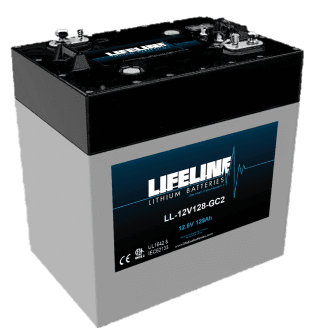 | LL-12V128-GC2 | 12v | 128Ah | -- | Details |
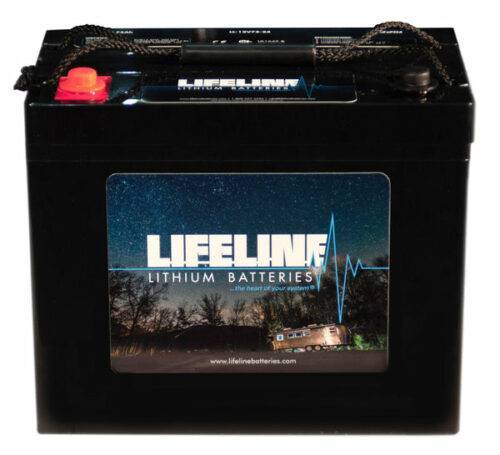 | LL-12V100-24 Lithium Battery | 12v | 100 Ah | -- | Details |
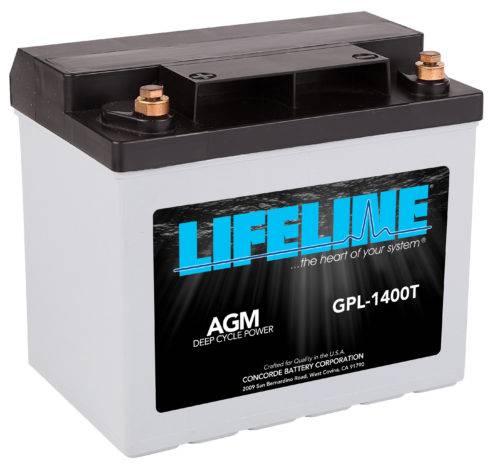 | GPL-1400T AGM RV/Marine Battery | 12v | -- | -- | Details |
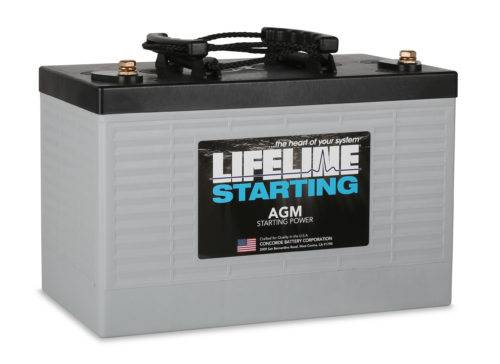 | GPL-3100T AGM RV/Marine Battery | 12v | -- | -- | Details |
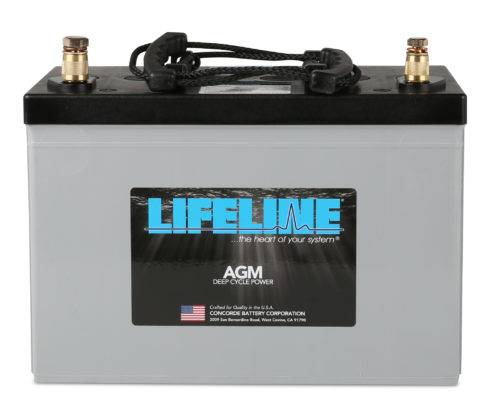 | GPL-2700T AGM Starting Battery | 12v | -- | -- | Details |
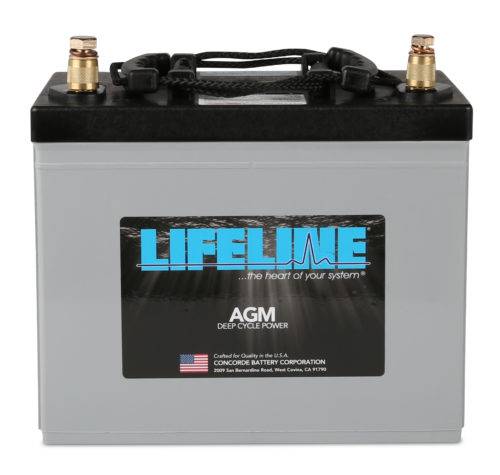 | GPL-2400T AGM Starting Battery | 12v | -- | -- | Details |
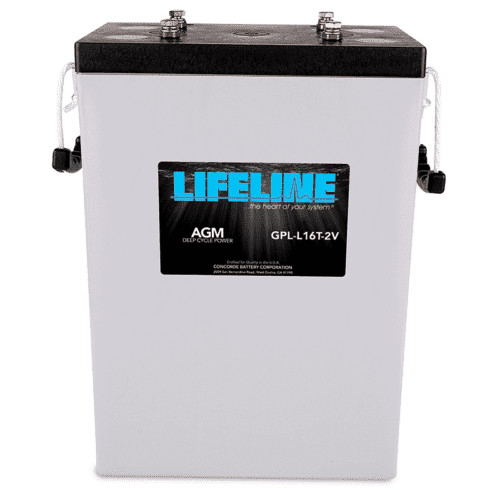 | GPL-L16T-2V AGM Battery | 2v | 1200 | 2850 | Details |
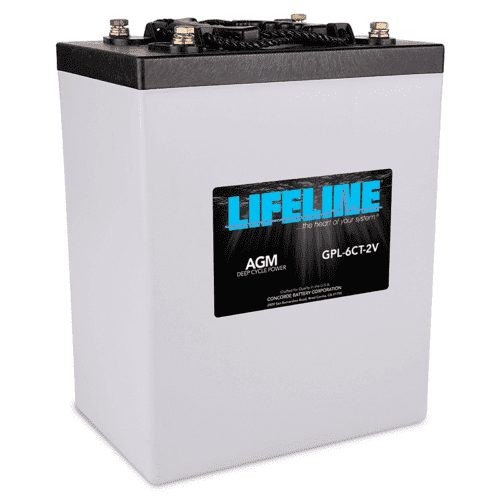 | GPL-6CT-2V AGM Battery | 2v | 900 | 2076 | Details |
 | GPL-4CT-2V AGM Battery | 2v | 660 | 1476 | Details |
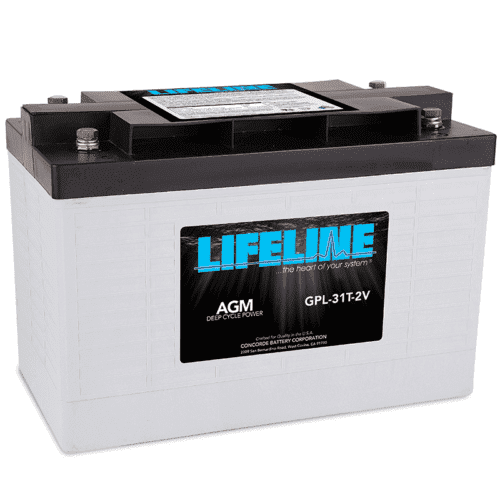 | GPL-31T-2V AGM Battery | 2v | 630 | 1170 | Details |
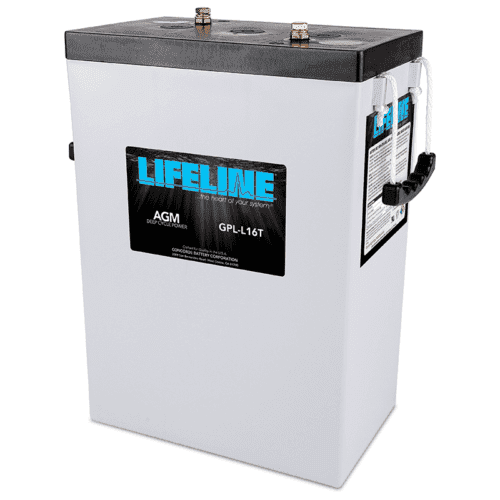 | GPL-L16T AGM Battery | 6v | 400 | 950 | Details |
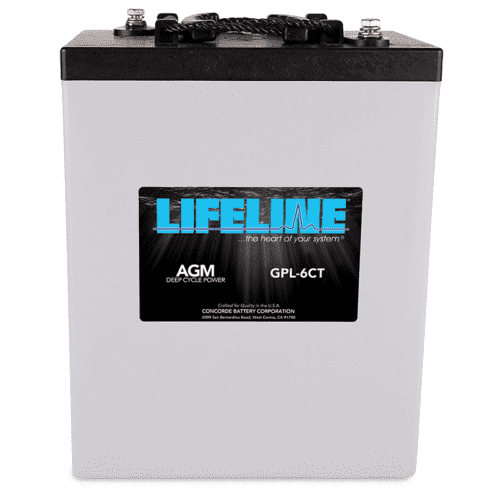 | GPL-6CT AGM Battery | 6v | 300 | 692 | Details |
 | GPL-4CT AGM Battery | 6v | 220 | 492 | Details |
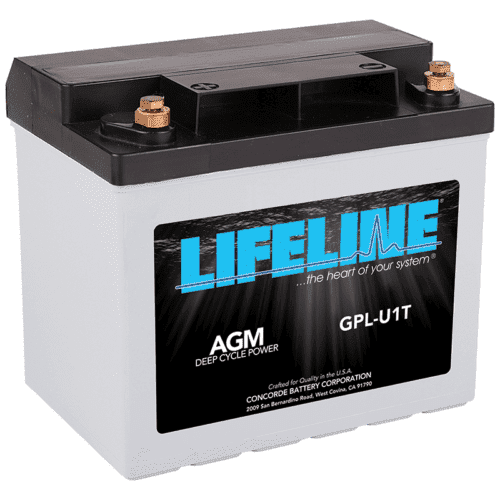 | GPL-U1T AGM Battery | 12v | 33 | 50 | Details |
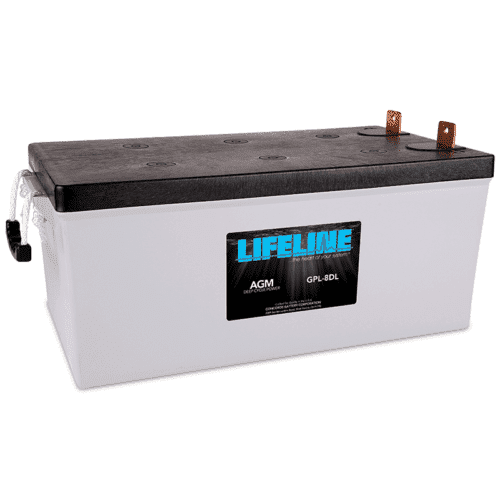 | GPL-8DL AGM Battery | 12v | 255 | 550 | Details |
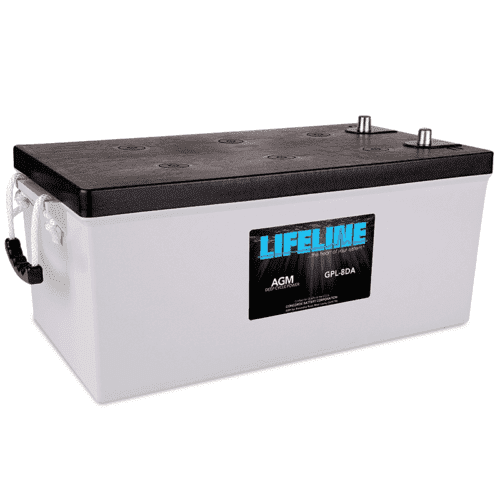 | GPL-8DA AGM Battery | 12v | 255 | 550 | Details |
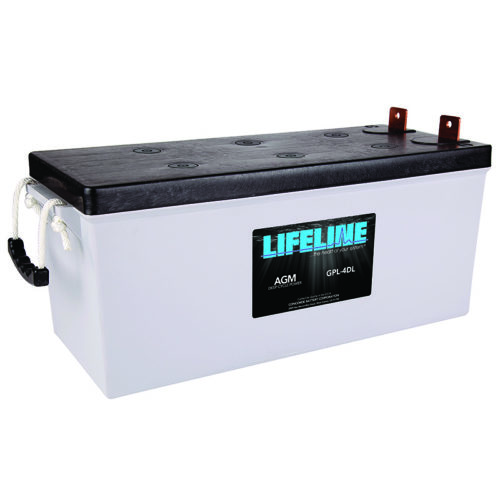 | GPL-4DL AGM Battery | 12v | 210 | 390 | Details |
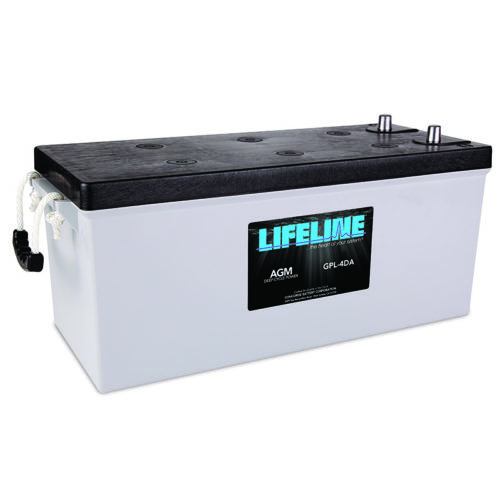 | GPL-4DA AGM Battery | 12v | 210 | 390 | Details |
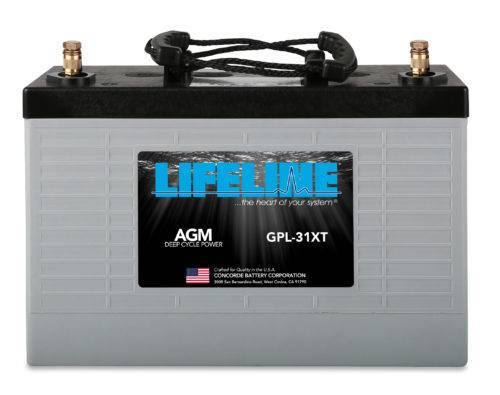 | GPL-31XT AGM Battery | 12v | 125 | 230 | Details |
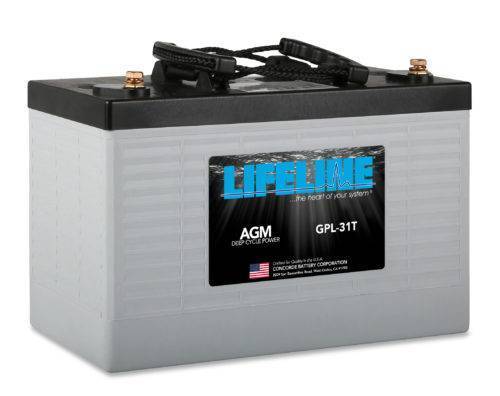 | GPL-31T AGM Battery | 12v | 105 | 195 | Details |
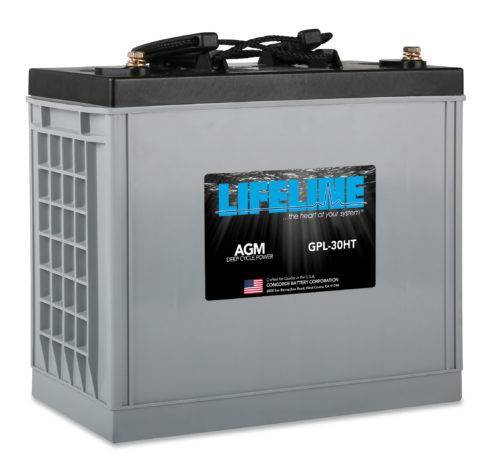 | GPL-30HT AGM Battery | 12v | 150 | 315 | Details |
 | GPL-27T AGM Battery | 12v | 100 | 186 | Details |
 | GPL-24T AGM Battery | 12v | 80 | 149 | Details |
| No Products Found | |||||
RV Battery Selection Guidelines and Info
Why we use deep-cycle batteries in the RV and Marine industries:
Recreational vehicles and recreational boaters have one main thing in common and that is they both like to head off into the wilderness and enjoy nature. Even though these two types of battery consumers like to get away from it all, most of them also like to enjoy access to select modern conveniences to make these trips more comfortable. Although each of these types of battery consumers have a multitude of differences in regard to their approach of getting away, they have one big thing in common. Both RV and Marine industry consumers have certain needs for power and in many cases, lots of it. They will need to have ways to generate and store power so they can benefit from its usage when required.
Remote Power Generation:
There are several ways to generate power whether from an isolated desert location or somewhere anchored in a cove somewhere in the Caribbean Sea. Some of these methods include wind generators, solar power and fossil fuel powered generators. Since the wind and sun are not always cooperative and generators are both expensive to operate and relatively noisy there arises a need to be able to store energy for use at a later time. Batteries are the device that makes this energy storage necessary.
What makes a battery deep-cycle capable:
Not just any type of battery is designed for this strenuous type of discharge and recharge life style. A true deep-cycle battery, like Lifeline Batteries, is what you will need to accomplish this task effectively. Deep-cycle batteries are specifically designed to handle the rigors of deep discharges and recharges with the most effective delivery of energy. Not all deep-cycle batteries are built to the same standards. You won’t get the same life expectancy from batteries that have thin flat plates or from thin spiraled plates, but only from the thickest positive plates in the industry like those used in Lifeline Batteries. In addition to thick flat positive plates, there is an array of materials and processes used in the manufacturing of Lifeline Batteries that make them top performers. There are special stabilizing materials used on the negative plates, the absolute highest micro porous glass matting, hand welded over the partition intercell connections and fully sealed and crimped edges all polyethylene separator material just to name a few. All of these steps and processes contribute to the unparalleled true deep-cycle performance that is delivered by Lifeline Batteries.
Several battery sizes to choose from:
Lifeline deep-cycle RV and marine batteries come in twelve, six and two volt forms and can be linked together in a combination of series and parallel connections to achieve the desired system voltage. The costs of batteries regardless of their size and voltage is driven mainly by the energy they can store and deliver, as well as their life expectancy. There are also several battery case sizes that makes it easy to accommodate different sized battery boxes. Battery Counsel International has a list of conforming battery group sizes to help in making accurate comparisons. Lifeline batteries come in a full array of these industry standard case sizes and additional industry specific custom sizes.
What is really included in the cost you pay for a battery:
As battery prices around the RV and marine industries can vary greatly, it is important to consider many factors prior to making a purchase. For instance, AGM batteries that claim to deliver industry competitive specs at a significantly reduced cost could prove to only be a short-term solution. AGM batteries manufactured in country’s far from the US will often incur additional shipping charges and import taxes that make up large portions of their overall costs. There is a direct cost involved in manufacturing industry leading AGM batteries that cannot be avoided without compromising manufacturing principles and product. As a multi- generational US family owned and operated battery company our core focus has always been on quality above quantity and customer and employee satisfaction.
How and where to hunt down a quality AGM battery option:
Lifeline has worked diligently to grow its vast dealer and distributor networks. Simply go to our website to access our dealer locator or contact us directly and we will put you in touch with a dealer near you. www.lifelinebatteries.com We have a number of national and international stocking dealers and rapid shipping throughout the US to satisfy most any location in short order.
RV Battery Papers
The goal of these RV battery papers is to provide insight into RV AGM batteries. Topics will include a detailed definition of the characteristics of deep-cycle RV batteries, proper charging practices and RV battery storage procedures. The last portion of these RV battery papers will cover battery testing procedures designed to assist in the diagnosis of damaged batteries.
Perhaps the single greatest challenge when the time comes to make the best RV deep-cycle battery selection, is sorting through the plethora of misinformation that is eternally circulating. What makes a Lifeline AGM deep-cycle battery a true deep-cycle battery? Thick positive battery plates are one of the biggest contributors to the deep-cycle battery concept and in fact, Lifeline positive battery plates are some of the thickest in the industry (Lifeline positive plate thickness of .095” to .105” vs other AGM brands of .045” to .060”. The thickness of the Lifeline battery positive plates enables them to be drawn down, or deeply discharged without damage. You can discharge Lifeline RV batteries to 100% without causing damage to the battery. It is important, however, to keep in mind that the deeper the depth of discharge the fewer life-cycles you will be able to utilize. Lifeline RV batteries provide industry leading life-cycles and boast 1000 to 1100 cycles at a 50% depth of discharge. In addition to the thickness of the positive battery plates, the chemistry of the proprietary lead oxide paste and acid ratios are also large contributors to the success Lifeline is experiencing throughout the RV and numerous other industries. Unlike any other RV AGM battery brands, Lifeline batteries can tolerate in-rush current levels as high as 5C (500A for a 100Ah battery) due to their extremely low internal impedance levels. Now that you’ve learned about the factors that constitute a true RV deep-cycle battery let’s move on to the proper charging for these batteries.
Although proper AGM battery charging techniques may seem like a bit of a mystery as a result of greatly differing industry information, it is really quite simple. What you take out of your RV battery bank you will need to replace fully or suffer the consequences of shortened battery life. All RV battery manufacturers have their own recommended charging perimeters and that is why it is best to go straight to the source. When you contact us at Lifeline for assistance you will be talking directly with the family and will get quick and accurate answers on all technical inquiries.
Recharging Lifeline RV AGM batteries is nothing more than replacing the amp hours you took out plus a little more to make sure they are fully charged. Think of this as charging your batteries to 102-110% of their rated capacity to get them back to 100% state of charge. The more amps you are willing to throw at your Lifeline batteries the faster the recharge time. If your charge routine continually falls short of the 100% mark, this will result in sulfation and consequentially a premature failure of your battery bank. For Lifeline batteries the recommended charging method is a three stage charge profile. The first stage is referred to as the bulk stage and this is where the current is held constant until the voltage reaches a preset limit. The charge voltages will vary based on temperature compensation. The second stage of charging is called the absorption stage and this is where the charge voltage is maintained at a particular value until the amperage tapers off to the recommended end mark. Lifeline AGM RV batteries are fully charged when they no longer accept more than 0.5amps per 100 amp/hour. This value will increase as the battery ages. How long a battery needs to stay in the absorption stage depends upon the size of the battery bank and the level to which it was discharged. The third and final stage of battery charging is referred to as the float stage and this is where a specific voltage range is set just high enough to maintain the batteries while not in use. See section 5.4 in the Lifeline technical manual for more detail descriptions of this process.
One of the hottest topics surrounding deep-cycle RV batteries is what to do to properly store them when not in use. Storing batteries properly can certainly be the difference between enjoying a long useful battery life or having them fail prematurely. The first thing to make sure happens prior to storing your batteries is confirming that they are fully charged. Storing your RV batteries in any state less than 100% state of charge will damage them. Once you have determined that your RV batteries are fully charged and that you will not need them to perform any tasks, it is best to fully disconnect them from your RV. If you have access to a power source you could also leave the batteries connected and on a float charge through the storage period. If you do not have access to a power source, but would prefer not to disconnect your RV batteries, you will need to boost charge your batteries with some regularity based on the size of DC phantom draws that exist on your particular RV. Keep in mind that your master battery switch will typically kill all significant DC draws, but additional phantom draws will continue to discharge your batteries. For fully charged batteries that are disconnected from any DC draws, we recommend that you put a maintenance charge on your batteries every 6 to 8 weeks. This period can be extended as the temperatures where the RV is being stored drop.
No RV deep-cycle battery discussion would be complete if it didn’t touch on diagnosing battery problems. Getting to the root of battery troubles can be both difficult and time consuming. The one good thing about batteries, however, is that through proper testing and diagnosis they provide good indicators as to what went wrong. You may decide that it is more preferred to leave your battery diagnosis to industry experts as it can be a detailed and confusing process. Even if you do not wish to tackle your battery diagnosis on your own, it is good to learn about some of the problem scenarios so you are familiar with what a battery technician will be doing on your behalf. The following RV battery symptoms (tab) are some of the most common scenarios from the RV industry. They are each followed by an action that can be taken to get to the root of the problem.
Symptom #1: Batteries won’t take or hold a charge.
Action: If your bank of batteries is showing signs of this condition you should begin diagnosing the problem by disconnecting all the batteries from each other and measuring their open circuit, ‘resting’ voltages. The goal is to eliminate the possibility that one battery may have a problem and is having an impact on the entire bank. If you determined that all the batteries are resting at roughly the same voltage, you can deduce that it is most likely not a battery defect that initiated the problem. Let’s assume that you have already charged your batteries as full as they can be charged you will need to make a note of the beginning battery voltages so you can see any changes that take place after a condition charge is applied. Before you begin any battery conditioning procedures you should determine the ages of all the batteries by checking the date codes printed on each battery. Dramatically differing date codes might lead to a quick conclusion. If all the date codes are similar you can begin the necessary processes to try and recover the batteries. Beginning with a ‘true’ load test can yield quick results from which you may begin to draw a conclusion. If results are inconclusive, battery conditioning procedures can be implemented. Battery Conditioning procedures for Lifeline batteries can be found in section 5.2 of the Lifeline technical manual on our website.
Symptom #2: Batteries fully charged (high voltage) little or no capacity.
Action: If your RV batteries are all showing good resting voltages there seems to be little to no capacity under a load you need to perform a ‘true’ load test. For Lifeline Batteries you will need to deliver a load roughly equal to three times the amp/ hr capacity of the battery for 15 seconds. Beginning with a fully charged battery, the voltage of a 12v battery should not drop below 9.6 volts. If the voltages drop significantly below the 9.6v range this provides evidence of a battery that has been continually overcharged to the point where water has escaped leaving a higher acid ratio that displays a healthy voltage with diminished capacity. Severe overcharging that has led to significant water loss cannot be remedied. A discharge test is helpful in this scenario as it will provide to an accurate account of what capacity is left in your batteries. Lifeline reserve capacities can be located on our website when you select a particular battery part number.
Symptom #3: Batteries are deeply discharged and not accepting a charge.
Action: If your batteries are in a deeply discharged state there are procedures you can follow that may help recover them provided they have not been sitting discharged too long. Many on-board charging devices won’t allow a charge to be distributed unless there is an existing nominal voltage of 8 volts or greater. You can find Lifeline RV battery deep discharge recovery procedures in section 5.6 in the Lifeline technical manual. If you do not have these capabilities it is recommended that you trickle charge 12v batteries until they reach 10v before hitting them with normal bulk charge voltages.
Hopefully this information has helped shed light on several facets of RV deep-cycle batteries. The durability and industry leading performance of Lifeline RV and Marine batteries, both deep-cycle and engine cranking, comes from more than 40 years of battery industry experience. We encourage everyone to reach out to us directly so we can help you avoid the perils of deep-cycle AGM battery misinformation and ultimately get you pointed in the right direction.
